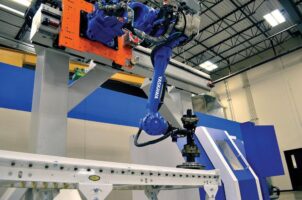ROBOTIC ARMS IN CNC MACHINING: A NEW ERA OF PRECISION
Robotic Arms in CNC Machining: A New Era of Precision
The integration of robotic arms in CNC (Computer Numerical Control) machining processes has ushered in a new era of precision and efficiency in the manufacturing industry. This technological advancement is transforming the way manufacturers produce parts and components, offering numerous advantages that can revolutionize the world of precision machining.
Enhanced Precision and Accuracy
Robotic arms are well-known for their precision and repeatability. When applied to CNC machining, these attributes translate into exceptional precision and accuracy in the manufacturing process. Robotic arms can execute complex tasks with sub-millimeter precision, ensuring that each component is machined to the exact specifications required. This level of precision is particularly valuable in industries like aerospace, automotive, and medical device manufacturing, where tight tolerances are essential.
Improved Efficiency and Productivity
Integrating robotic arms with CNC machines enhances efficiency and productivity. Unlike human operators, robotic arms can work tirelessly 24/7 without breaks, leading to a significant reduction in production time. They also eliminate the need for shift changes, which can result in a seamless, continuous machining process. This increased efficiency not only reduces lead times but also lowers manufacturing costs.
Complex Geometries and Flexible Machining
Robotic arms offer unmatched flexibility when it comes to handling complex geometries and varied part sizes. They can effortlessly adapt to different workpieces and machining tasks, making them ideal for small-batch and high-mix, low-volume production. Manufacturers can easily switch between different workpieces without the need for extensive retooling, thereby increasing operational agility.
Improved Safety
Safety is a paramount concern in manufacturing environments. Integrating robotic arms in CNC machining processes helps improve workplace safety by reducing the risk of accidents and injuries. Robots can handle hazardous materials, high-temperature workpieces, and perform tasks in environments that may be dangerous for humans. This not only safeguards workers but also contributes to a more secure and compliant manufacturing facility.
Reduced Scrap and Material Waste
Robotic arms can significantly reduce scrap and material waste in CNC machining. Their precise movements and adaptability minimize errors in the machining process, resulting in fewer defective parts. This directly translates into cost savings, as manufacturers can optimize material usage and reduce the need for rework.
Remote Operation and Monitoring
Robotic arms equipped with the latest technology can be remotely operated and monitored. This feature allows manufacturers to oversee and control machining processes from anywhere in the world. It facilitates real-time adjustments, maintenance, and troubleshooting, ensuring continuous production even when personnel are not on-site.
Integration with AI and Machine Learning
The synergy between robotic arms and AI (Artificial Intelligence) is a game-changer in CNC machining. AI algorithms can optimize machining parameters, predict maintenance needs, and detect defects in real-time. By harnessing the power of machine learning, manufacturers can continuously improve the quality and efficiency of their machining processes.
Conclusion
The integration of robotic arms in CNC machining has opened new horizons for precision manufacturing. The enhanced precision, efficiency, flexibility, and safety they bring to the table are reshaping industries and enabling manufacturers to meet increasingly demanding standards. As technology continues to advance, the synergy between AI and robotic arms promises even greater achievements in CNC machining, propelling us into a new era of precision manufacturing. Manufacturers who embrace this transformative technology stand to gain a competitive edge in the ever-evolving world of precision machining.


